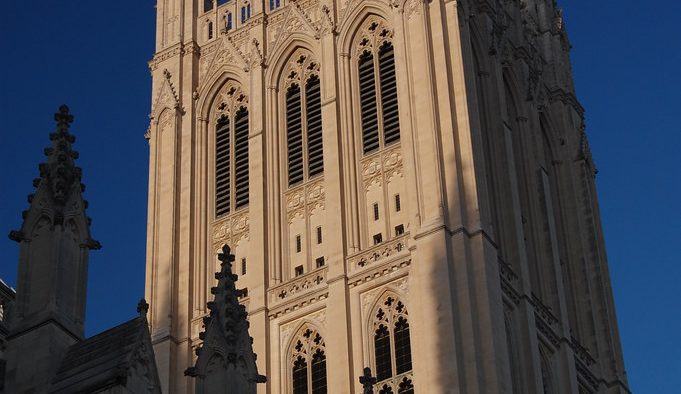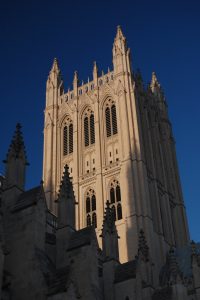What is a Mainline Christian, Anyway?
A recent survey raises new questions about an old tradition.

Is it a denomination? Is it a set of theological beliefs? Is it the type of church you attend? How exactly do you define a mainline Protestant Christian?

It’s a question asked by many on July 8 after polling outfit, Public Religion Research Institute (PRRI), unveiled a new survey that showed white mainline Protestant Christians outnumbering white evangelical Christians in America — a marked shift that surprised some observers.
To be fair, many were asking the question long before that survey — including mainline Christians, who often don’t use the term to describe themselves. (Not to mention, the copious amount of ink spilled in efforts to nail down a precise definition for “evangelical” — a debate still ongoing.)
Not unlike their evangelical step-cousins, mainliners are in the middle of their own identity crisis. Who’s in and who’s out depends a bit on who is answering the question.
Pollsters such as PRRI and others often apply a broad brush, using “white mainline Protestant” to describe people who identify as white, non-Hispanic, and Protestant, but who do not consider themselves evangelical or “born-again.”
The moniker has taken on a more precise meaning in common parlance, although its origins are somewhat murky. Some believe it originates from Philadelphia suburbs known as the “Pennsylvania Railroad Main Line” that were historically home to primarily white, wealthy churches.
Regardless of the title’s source, mainline Protestants are most often associated with an array of older Protestant denominations, such as the United Methodist Church, Evangelical Lutheran Church in America, Presbyterian Church (USA), Episcopal Church, Christian Church (Disciples of Christ), and United Church of Christ, among others.
Access to MinistryWatch content is free. However, we hope you will support our work with your prayers and financial gifts. To make a donation, click here.
Established institutions differentiated mainliners from some early 20th-century fundamentalists, many of whom later rebranded as evangelicals and belonged to communities that were more diffuse in a variety of ways. The National Association of Evangelicals defines the evangelical tradition according to a set of theological beliefs known as the Bebbington Quadrilateral, but the exact parameters of evangelicalism remain a matter of heated debate. While large denominations such as the Southern Baptist Convention exist, many evangelicals remain denominationally unattached to this day.
For their part, mainliner demography varies from church to church, with many congregations exhibiting a wide range of economic and racial diversity. But statistically, mainliners tend to resemble their probable historical namesake, skewing white and relatively wealthy. Their members can also be influential. The lion’s share of U.S. presidents — including Barack Obama, who said he came to Christ in a United Church of Christ church, and Donald Trump, who initially identified as Presbyterian — have hailed from mainline traditions at some point in their lives, if not during their presidency.
Mainline traditions diverged from evangelicals in several ways throughout the 20th century, usually upholding more liberal theological stances. Early movements such as the Social Gospel, which decried social injustices such as economic inequality and child labor as sin, had a lasting impact on both political progressivism in the U.S. and mainline Protestantism, informing clergy who went on to participate in the civil rights movement.
Meanwhile, mainline Protestantism often served as a counterbalance to evangelicalism. The National Association of Evangelicals and the Christianity Today publication, for example, were seen or explicitly founded as counterpoints to the Federal Council of Churches (now the National Council of Churches) and the Christian Century, both primarily mainline Protestant projects.
Mainline leadership still tends to lean liberal. Several, though not all, mainline denominations now formally ordain women and LGBTQ people or officiate same-sex weddings — practices many evangelical Christians refuse to condone. Leaders from various mainline traditions were also deeply critical of former President Trump, with many participating in protests against his policies.
Through collaborations with interfaith clergy and Black Protestant leaders, mainline clergy repeatedly found themselves in direct confrontation with Trump during his presidency, as well as with his supporters.
When police cleared hundreds of racial justice demonstrators from Washington’s Lafayette Square in June 2020, the Rt. Rev. Michael Curry, presiding bishop of the Episcopal Church, criticized the move, accusing the president of using “a church building and the Holy Bible for partisan political purposes.”
A recent government investigation “did not support a finding that the [U.S. Park Police] cleared the park to allow the President to survey the damage and walk to St. John’s Church.”
On Jan. 6, 2021, shortly before protestors entered the U.S. Capitol, a group of interfaith clergy — including mainliners — gathered around a Black Lives Matter sign outside an ELCA church as a counter protest against Trump supporters who had descended on Washington, D.C., to decry Joe Biden’s election as president.
Yet mainline pews are filled with a more politically diverse group than their pulpits, although they still skew less conservative than evangelicals. According to PRRI, 33% of mainliners identify as Republican, 35% identify as Democrat, and 30% identify as independent.
Moreover, many mainline traditions have splintered multiple times over the past century, giving birth to smaller, more conservative iterations. For example, the Lutheran Church–Missouri Synod is understood to be more theologically conservative than the ELCA, just as the Presbyterian Church in America is a more conservative breakaway from what became the PC(USA).
Like many faith traditions, mainliners often belie neat definitions. Some who attend mainline churches, particularly conservative ones, may identify as evangelical or born-again, even if other members of the tradition do not. Others may switch traditions over time: Trump identified as Presbyterian when elected as president in 2016, but identified as a “nondenominational Christian” by the time he left office.
Some polling outfits have begun to take a more complicated look at the term. PRRI updated its most recent survey to designate the group as “White mainline (non-evangelical) Protestants,” and Pew Research, which used the same rubric to define mainliners for some time, recently changed the category title to “White Protestant, not evangelical.”
In an email to Religion News Service, Greg Smith, Pew’s associate director of research, explained that his team still uses “white mainline Protestant” to categorize people who list specific affiliations with denominations traditionally described as mainline. But when using the less specific method, he argued the broader category is a more accurate way to describe the survey question.
“We made this shift in labeling because the ‘White Protestant, not evangelical’ label is a more accurate representation of the way Protestants describe themselves when we measure religious affiliation this way,” he said. “They have told us they do not think of themselves as born-again/evangelical Christians. They have not told us they identify with a mainline denomination.”
As for mainline denominations, their churches have seen a general decline in membership in recent years. PRRI’s data suggests that may be changing, but even if it doesn’t, mainliners have yet to give up their voice in the public square, particularly when it comes to liberal activism. Both co-chairs of the influential Poor People’s Campaign — the Rev. William Barber and the Rev. Liz Theoharis — belong to mainline traditions (Disciples of Christ and the PCUSA, respectively).



